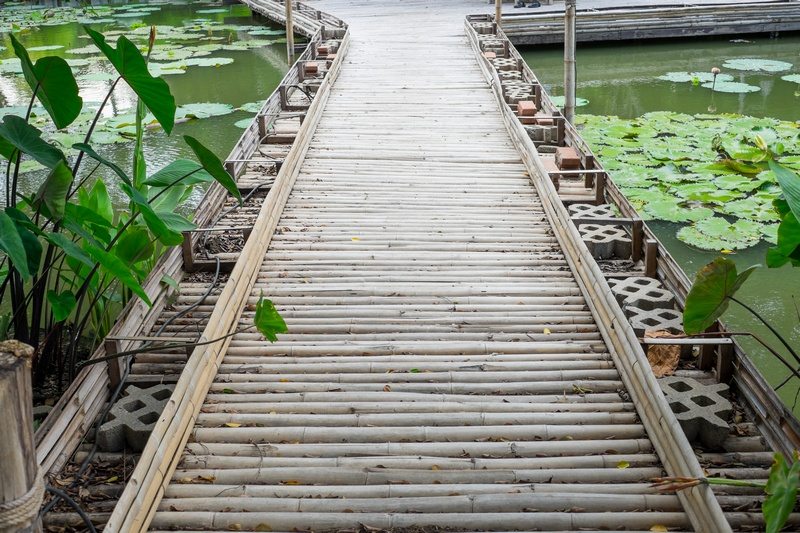Last Updated on April 3, 2018 by teamobn
Bamboo flooring is becoming an increasingly popular option in new homes and in renovations. Before deciding whether to install a bamboo floor , it’s important that you know and understand the advantages and disadvantages of using this material for your project.
The Advantages of Bamboo Flooring
There are many advantages to bamboo including its environmental friendliness, durability, suitability, cost, variety of styles, warmth, and ease of maintenance. For many, these advantages make the choice to use bamboo an easy one. Let’s take them one at a time:
Environmentally Friendly
Bamboo is an excellent choice for anyone interested in building a “green” home or place of business. It’s probably the most environmentally friendly flooring on the market today. Bamboo is a type of grass. It grows quickly in comparison to trees. And it is harvested, not felled. It continues to grow without needing to be replanted, so it is highly renewable. If you’re worried about moisture or insects, relax. The bamboo used for flooring is treated against both. As a bonus, neither treatment uses harsh chemicals or pesticides!
Leadership in Energy and Environmental Design (LEED) uses the Green Building Rating System developed by the United States Green Building Council (USGBC) as a set of standards regarding the environmentally friendliness of a particular building. The organization certifies buildings as “green” and looks at bamboo flooring as one of the best flooring options for this status. It’s also important for you to know that the vast majority of bamboo products, including flooring are made from a species called Moso. It is very vigorous, plantation grown and is not on the ‘panda diet’ 🙂

Durability
The Janka Hardness Scale is used to determine the hardness and strength of timber species. Both solid and engineered bamboo flooring scorevery well on the scale.
The Janka test measures the force required to embed an 11.28mm (0.444 in) steel ball to half its depth into wood. The Janka hardness test is the industry standard for determining the ability of a particular timber species to withstand denting and wear. Here, in Australia, Janka results are displayed in either newtons (N) or kilonewtons (kN).
Here are some examples of Janka ratings:
[table id=1 /]
Bamboo flooring’s hardness make it a very durable flooring choice for any location that is subjected to heavy traffic. It stands up very well to the abrasion caused by children and pets. It is tough enough to resist the impact of falling objects in the kitchen, as well as in high traffic areas such as the living rooms and hallways.
Bamboo has a greater compressive strength than concrete and about the same strength-to-weight ratio as steel when subject to tension, yet it’s a whole lot kinder on your body! Your legs, feet and knees do not experience as much strain and stress while standing on bamboo as they do when standing on concrete or tiles.
Climatic Suitability
Compared to hardwood and other flooring options, bamboo has a high climatic suitability because it grows in the tropics. This makes it a suitable option for the kitchen and laundry rooms, areas where hardwood does not work so well. Bamboo also does equally well in both arid and humid climates because it does not swell and contract like hardwood. To understand the stability of bamboo, consider what happens when you put timber utensils in your dishwasher… they never come at the same as they went in. Yet bamboo utensils can be put through the dishwasher again and again without damage.
Cost Effectiveness
When considering the durability of the flooring combined with the looks, and eco-friendly factor, bamboo flooring is one of the most cost effective options for a home because it is less likely to need repair in the long run.
Variety
No matter what taste there is to consider, bamboo flooring has an option guaranteed to please. The natural grain provides a unique look, and there are three main options for color: natural bamboo—light blonde color, carbonized bamboo—darker in color because the sugars in the plant caramelize due to longer boiling times, and stained bamboo—colored with a variety of stains available in light, medium, and dark shades.
For those who want the strength and durability of bamboo with the look of another type of floor, direct print bamboo is an option. Before this flooring is sealed, the pattern of another type of flooring, such as oak or cherry, is printed on. Regardless, there is a bamboo flooring choice to suit any décor.

Warmth
Bamboo flooring adds an extra touch to the home, providing a comfortable feeling because of the natural look and feel of the material. The naturally attractive material may even evoke a sense of serenity.
Maintenance
Another selling point for bamboo flooring is how easy it is to take care of. Special cleaning agents are not needed and in fact should be avoided. Simply sweeping the floor is usually enough to clean it though sometimes, a damp mop can be used. The mop should not be too wet, as this could damage the flooring.
Disadvantages of Bamboo
While the advantages certainly outweigh the disadvantages of bamboo, there are a couple of them to acknowledge. It cannot be installed in high-moisture rooms in the home and can be difficult to cut if you are not using the correct saw blade (a cross-cut blade works best).
Cannot Install Throughout the Home
While the durable flooring is suitable for high traffic areas, the kitchen and the laundry room, it is not suitable for outdoor use or in areas of the home susceptible to large amounts of moisture.
Where to Install Bamboo Flooring
Bamboo flooring can be installed in almost any room, above or below the ground, over wood, OSB (Oriented Strand Board), and existing vinyl flooring. Focus on high traffic areas such as the living room, and hallways, as well as areas prone to scratching and denting, such as the kitchen, laundry room, and bedrooms.
Where Bamboo Should Not Be Installed
Bamboo flooring is not suitable in areas prone to excessive wetness such as bathrooms. Avoid outdoor areas or areas that require wet mopping. Extended exposure to moisture can cause a bamboo flooring to warp, bend, or swell.
The Bottom Line…
Beautiful and stylish, bamboo flooring is more durable and more stable than most timber flooring. Bamboo floors have very high moisture resistance, resulting in minimum expansion and contraction of the boards following installation. Bamboo flooring also has strong resistance to diseases, insects and climate damage. Because harvestable bamboo takes only four to five years to mature, bamboo is both a genuine and a rapidly renewable natural resource.
We hope that helps with your flooring decisions. If you have anything to add or a question to ask, just scroll down to the comment box below.
You might also enjoy reading our comparison of Australian hardwood flooring…








